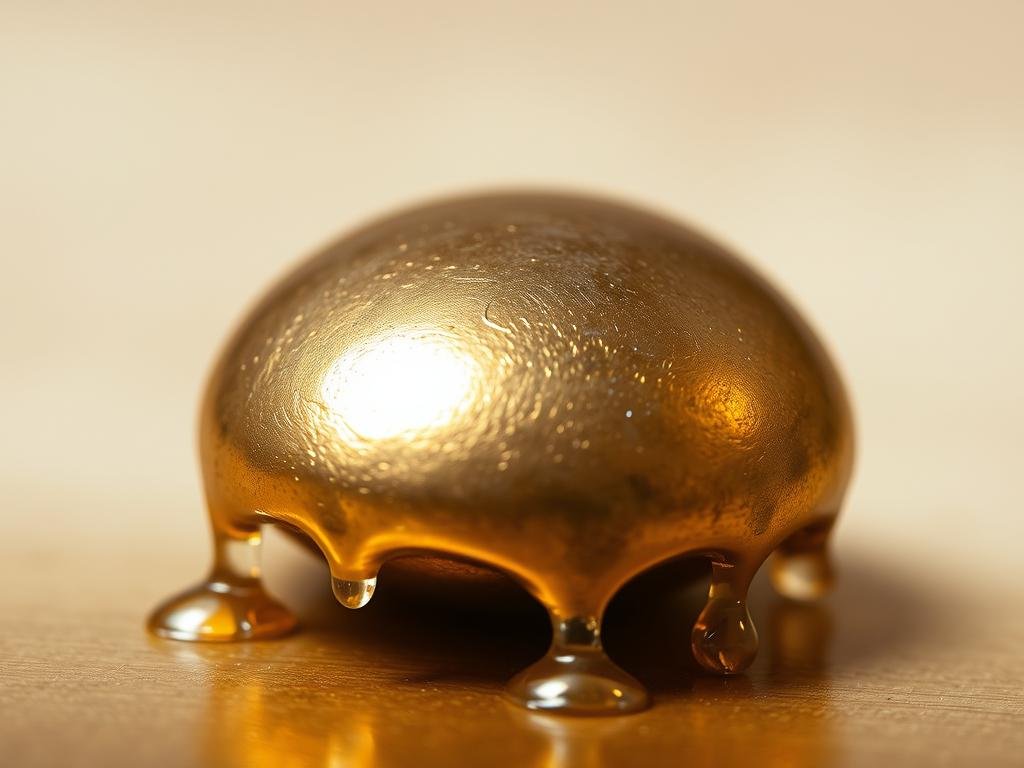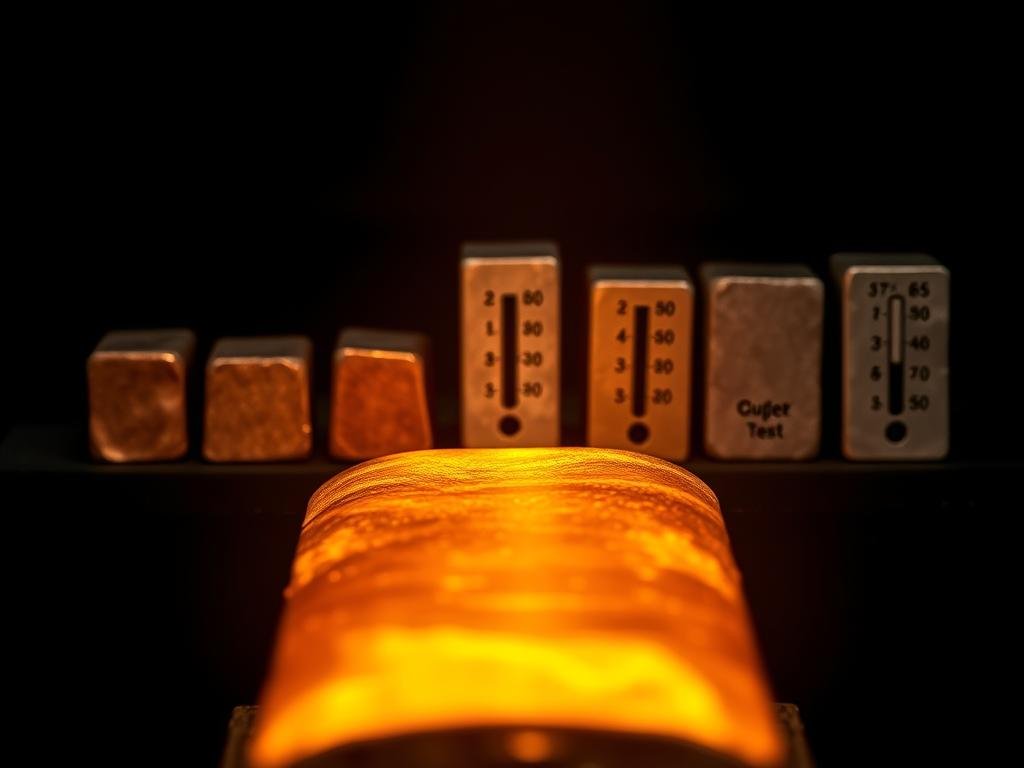Brass, an alloy made by combining copper and zinc, is widely used across various industries due to its unique properties, including corrosion resistance and aesthetic appeal.
The température at which brass melts is not fixed, but rather falls within a range, typically between 890°C and 1000°C (1650°F and 1830°F), depending on its composition.
Understanding the melting point of this metal alloy is crucial for manufacturing processes and material selection.
Les proportions variables de cuivre et de zinc dans le laiton affectent son comportement de fusion, ce qui rend essentiel de prendre en compte ces facteurs lors du travail avec cet alliage.
Understanding Brass as an Alloy
Laiton, étant un alliage principalement composé de cuivre et de zinc, offre une combinaison unique de propriétés qui en font un matériau précieux matériel dans diverses industries.
The properties of brass are significantly influenced by the proportion of its main éléments, copper and zinc.
Composition and Properties of Brass
Brass is fundamentally an alloy composed primarily of copper and zinc. The typical copper content ranges from 55% to 95%, and zinc content from 5% to 45%.
| Élément | Plage typique |
|---|---|
| Cuivre | 55% – 95% |
| Zinc | 5% – 45% |
| Lead | 0.5% – 3.5% |
| Tin | 0.5% – 1.5% |
The ratio between copper and zinc significantly influences the propriétés of brass, including its color, strength, ductility, and point de fusion.
Additional elements may be present in smaller quantities to enhance specific properties.
- The versatility of brass as a matériel stems from its adjustable composition.
- Brass has excellent mechanical and wear resistance properties.
- It’s ideal for creating precision instruments, ship parts, and other components.
The Melting Point of Brass Explained
Brass, being an alloy, doesn’t have a precise melting point like pure metals; instead, it exhibits a melting range. This characteristic is crucial for understanding its behavior under various thermal conditions.
Definition of Melting Point in Metallurgy
In metallurgy, the melting point is defined as the temperature at which a solid metal transitions to a liquid state. This phase change is critical in determining the material’s structure and properties. As “the melting point is the temperature at which a material undergoes a change of state”, it’s a fundamental property that influences how materials are processed.
Typical Melting Range for Brass
The typical melting range for brass falls between 900°C and 940°C (1650°F and 1720°F), though this can vary based on the specific brass composition. Unlike pure metals, brass goes through a “mushy” phase during melting, where solid and liquid states coexist. Understanding this melting range is crucial for manufacturing processes like casting, where precise temperature control determines the quality of the final product.
Factors Affecting Brass Melting Point
Understanding the factors that affect the melting point of brass is crucial for various industrial applications. The melting behavior of brass is influenced by its composition and microstructure.
Impact du ratio Cu-Zn
The copper-to-zinc ratio is a primary factor affecting the melting point of brass. A higher copper content, which melts at 1085°C, raises the melting point, while a higher zinc content, melting at 419.5°C, lowers it. For instance, brass with approximately 70% copper and 30% zinc typically melts at around 940°C, whereas brass with 60% copper and 40% zinc melts at around 900°C.
Influence of Additional Alloying Elements
Additional alloying elements such as lead, tin, and aluminum can significantly alter the melting characteristics of brass. Lead, in particular, is known for lowering the melting point. These elements can change the alloy’s microstructure, thereby affecting its melting behavior.
Effect of Impurities and Microstructure
Impurities in brass can disrupt its regular atomic structure, often resulting in a lower melting point. The microstructure, including grain size and distribution, also affects how heat is distributed throughout the material during heating, influencing the melting behavior.
| Factor | Effet sur le point de fusion |
|---|---|
| Copper Content | Increases melting point |
| Zinc Content | Decreases melting point |
| Additional Alloying Elements | Can lower or alter melting point |
| Impurities | Can lower melting point |

Melting Points of Different Brass Grades
Comprendre les points de fusion de diverses alliages de laiton est essentiel pour les processus de fabrication. Différents grades de laiton ont des plages de température de fusion distinctes en raison de variations dans leur composition.
Alpha Brass Melting Temperatures
Alpha brass, containing up to 35% zinc, typically melts between 900°C to 965°C (1650°F to 1770°F). This single-phase microstructure brass is commonly used in applications requiring good cold-working properties.
Beta Brass Melting Temperatures
Beta brass, with a zinc content between 35-45%, has a higher melting range of 990°C to 1060°C (1820°F to 1950°F). It offers superior hot-working characteristics but is more brittle at room temperature.
Special Brass Alloys and Their Melting Points
Specialized brass alloys, such as naval brass and cartridge brass, have unique melting points. Naval brass melts between 900°C to 1060°C (1650°F to 1950°F), while cartridge brass melts between 900°C to 930°C (1650°F to 1710°F). These alloys are designed for specific applications, such as marine hardware and deep-drawing processes.
The melting points of these brass alloys are critical for their processing and application. For instance, high-performance brass alloys containing elements like aluminum or silicon can have melting points exceeding 1000°C (1830°F), offering enhanced strength and heat resistance.
Why Brass Doesn’t Have a Fixed Melting Point
Brass is known for its versatility, but one of its most intriguing properties is its lack of a fixed melting point. This characteristic can be confusing for those familiar with pure metals that have precise melting points.
The Science Behind Variable Melting Points
The reason brass doesn’t have a fixed melting point lies in its composition. As an alloy primarily made of copper and zinc, brass’s melting behavior is influenced by the different melting points of its constituent elements. Copper melts at 1085°C, while zinc melts at 419.5°C.
How Composition Creates Temperature Ranges
The combination of copper and zinc in brass results in a melting range rather than a fixed point. As brass is heated, it goes through a “pasty” or “mushy” range where some portions are solid while others are liquid. This temperature range is known as the “solidus-liquidus range.”
- The width of this melting range is influenced by the composition of the brass.
- More complex alloys typically have wider melting ranges.
- The variable melting point of brass is advantageous in certain manufacturing processes like casting.
| Composition de l'alliage | Plage de fusion (°C) |
|---|---|
| High Copper Content | 900-920 |
| High Zinc Content | 880-900 |
The melting range of brass is a critical property that affects its applications. Understanding this property is essential for optimizing manufacturing processes.
Comparing Brass Melting Point to Other Metals
Understanding how brass compares to other metals in terms of melting point is crucial for selecting the right material for various applications. The melting point of an alloy like brass, which is primarily composed of copper and zinc, falls between that of its constituent metals.
Brass vs. Copper and Zinc
Brass melts at approximately 930°C (1710°F), which is between the melting points of copper (1084°C or 1983°F) and zinc (420°C or 787°F). This demonstrates how alloying elements can create materials with intermediate properties, useful for specific engineering applications.
Brass vs. Other Common Metals
Comparé à d'autres métaux d'ingénierie courants, le laiton a un point de fusion modéré. Il est supérieur à celui de l'aluminium (660°C ou 1220°F) et du plomb (328°C ou 622°F), mais inférieur à celui de l'acier (1425-1540°C ou 2597-2800°F) et du titane (1670°C ou 3038°F). Ce fait du laiton plus économe en énergie pour la coulée et la mise en forme que les métaux à point de fusion plus élevé.
Metals with Higher and Lower Melting Points
Refractory metals like tungsten (3400°C or 6152°F) and molybdenum (2620°C or 4748°F) have significantly higher melting points than brass, making them suitable for extreme high-temperature applications. Conversely, metals like lead and zinc have lower melting points, making them less suitable for high-temperature uses.

Practical Applications of Brass Melting Point Knowledge
Understanding the melting point of brass is crucial for various industrial applications. Knowing the melting point helps in choosing the right brass material for the right applications, ensuring that the material can withstand the required temperatures without losing its properties.
Manufacturing and Casting Processes
In manufacturing and casting processes, precise knowledge of brass’s melting point is essential. This knowledge helps in setting optimal furnace temperatures, ensuring complete melting without overheating, which can lead to zinc volatilization and altered alloy properties. Foundries rely on melting point data to design efficient casting processes.
Welding and Joining Techniques
For welding and joining techniques, understanding the melting behavior of brass is critical. This understanding affects filler material selection, heat input requirements, and the potential for dezincification in the heat-affected zone. Proper techniques ensure strong and durable joints.
High-Temperature Applications
Engineers designing components for high-temperature environments must consider brass’s melting point as an absolute upper limit. Typically, continuous operating temperatures are limited to no more than 200-300°C below the melting point, ensuring the material’s integrity and performance.
| Application | Temperature Consideration | Brass Alloy Selection |
|---|---|---|
| Manufacturing and Casting | Optimal furnace temperatures | High-copper brasses for higher temperature resistance |
| Welding and Joining | Heat input requirements | Leaded brasses for lower processing temperatures |
| High-Temperature Environments | Limiting operating temperatures | Special brass alloys for specific temperature ranges |
How to Properly Melt Brass
Melting brass requires careful consideration of several factors to achieve the desired outcome. The process involves understanding the material properties, using appropriate equipment, and following a precise procedure.
Equipment and Safety Considerations
To melt brass safely, one needs a furnace capable of reaching at least 1000°C (1832°F), crucibles that can withstand high temperatures, and protective gear such as heat-resistant gloves and face shields. Safety considerations are paramount due to the extreme temperatures and potential for metal splatter and zinc oxide fumes.
Processus de fusion étape par étape
The melting process begins with material preparation, ensuring the brass is clean and dry. The furnace is preheated, and flux is added to prevent oxidation. The brass is then carefully charged into the crucible, and the temperature is monitored throughout the process to ensure it reaches the optimal température de fusion, typically around 1,650°F (900°C) for common brass alloys.
Erreurs courantes à éviter
Common mistakes include inadequate ventilation, improper flux usage, overheating, and pouring molten brass into improperly prepared molds. These errors can lead to dangerous situations, such as steam explosions, or result in poor-quality castings.
Conclusion
Brass melting point knowledge is vital for optimizing manufacturing processes and material selection. Understanding the brass melting point is essential for anyone working with this versatile material, as it directly impacts manufacturing processes, material selection, and application suitability.
The melting point of brass typically ranges from 900°C to 940°C, varying based on the specific alloy composition. Unlike pure metals, brass doesn’t have a fixed melting point but rather a plage de fusion due to its nature as an alloy. Factors affecting the melting point include composition, impurities, microstructure, and external conditions such as pressure.
Knowing the melting temperature of brass allows manufacturers to optimize energy usage and ensure the material’s properties are preserved during manufacturing. As material science advances, new brass alloys continue to be developed with modified melting characteristics to meet modern manufacturing demands. By applying the principles outlined in this article, you can make informed decisions about brass selection, processing, and application.
